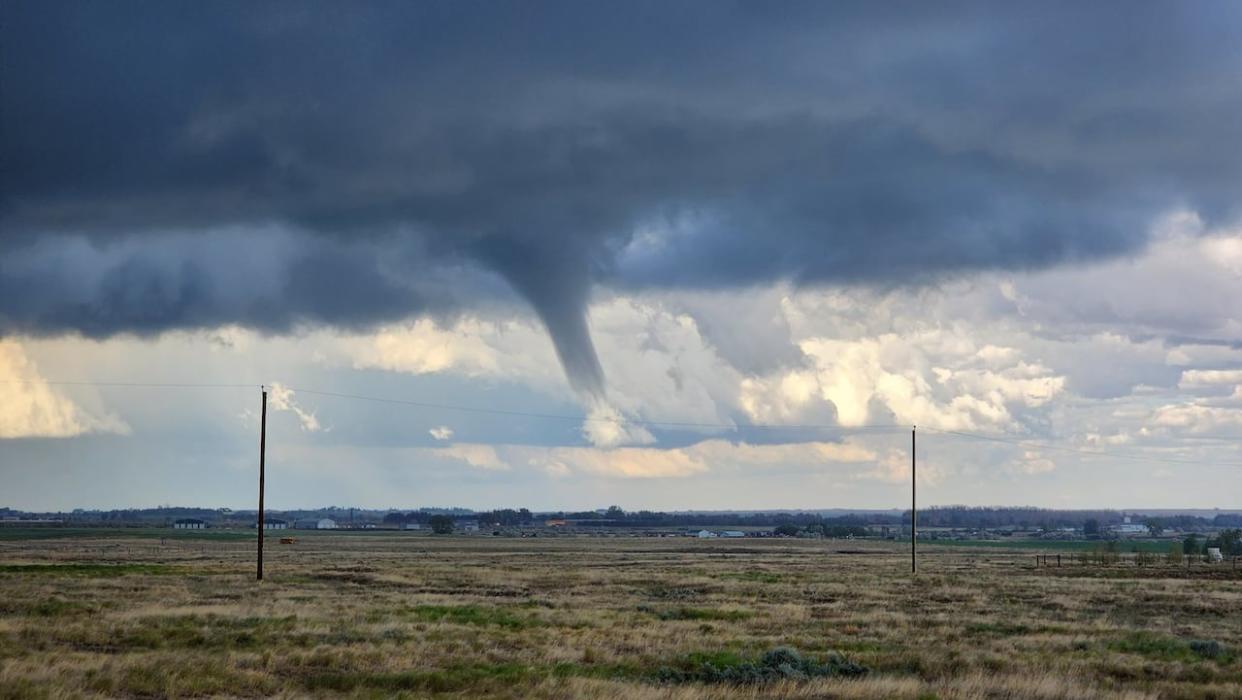Alberta's tornado season may have been impacted by wildfire smoke, forecasters say

Parts of central and southern Alberta didn't see as much tornado activity over the summer compared to past seasons due to the smoky aftermath of this year's wildfires, according to Environment and Climate Change Canada.
Forecasters recorded 21 confirmed tornadoes in Alberta from May to September. Four of those storms were recorded as being severe, while the remaining 17 were classified as non-supercell tornadoes.
Natalie Hasell, a warning preparedness meteorologist with Environment and Climate Change Canada, said non-supercells, also known as landspouts, are still tornadoes by definition, but often don't hold the same traits as a run-of-the-mill storm.
"It's still a thunderstorm but not one of those big massive ones," she said in a phone interview on Wednesday.
Most of this year's tornado season, Hasell said, focused on areas in southern and central Alberta, primarily in the Foothills region near Calgary. Storms also made landfall earlier in the season.
Many confirmed reports took place in mid-June and throughout the month of July.
Hasell said the smoke from this year's wildfires might have played a role in how many thunderstorms Alberta saw.
She said the ground couldn't heat up as much with the sun being blocked by the smoke, a major factor in thunderstorms developing. Since severe thunderstorms are often required for tornados to develop, Alberta saw fewer storms than if the skies had been clear.
"On days where the smoke is particularly thick — but even on days where it's just kind of hazy — you just don't see the temperature you need to kick stuff off," said Hasell.
"You don't see the atmosphere become unstable, so you don't get the thunderstorms."
Still, Hasell said Environment Canada's current data is too vague at this point to precisely determine how this year's tornado season compares to past years.
Alberta's average for confirmed severe tornadoes is between eight to 10, lower than what the province saw this year. But Hasell said the average doesn't make the distinction between supercell tornadoes, severe storm tornadoes and non-severe landspouts.
"Without making the distinction between landspouts, supercell tornadoes and other severe thunderstorm tornadoes, this year's number is higher than usual," said Hasell.
"But if we were to dig down, maybe this year was a little bit quieter since there were only four supercell tornadoes that have been confirmed."
Other major weather events

The Northern Hail Project collected bags of tennis ball-sized hail in July in an area north of Calgary. Data by Environment Canada found Alberta saw 124 severe hail storms from May to September. (Northern Hail Project)
The most common weather events across Alberta and the majority of the prairies was hail.
Environment Canada data found Alberta saw 124 severe hail storms, followed by Manitoba at 96 and Saskatchewan at 59.
Hasell said any tornadic storm will have large hail because they happen for the same reasons.
"But you don't need a tornado for there to be large hail," she said.
There were also 41 severe wind events reported in Alberta, while Manitoba recorded 24 and Saskatchewan confirmed 13, which Hasell said is lower than in previous years.
But Saskatchewan did see slightly more severe rain events compared to past seasons, recording 16 storms. Alberta came second at 15 and Manitoba recorded 14.
Estimates from the Insurance Bureau of Canada suggest severe storms in Alberta and the Prairies this summer resulted in more than $300 million in insured losses, not including insured damages from the ongoing wildfires.
"This is the third straight summer in which Alberta has seen significant insured damage from hail, wind and rain," said Aaron Sutherland, vice-president for Pacific and Western at the Insurance Bureau of Canada.
"The trend is clear, and it's important that consumers work with their insurance representative to ensure they have the right coverage to protect their property or business from the impacts of these storms."
The report cited major storms summer like Central Alberta flooding, a Calgary hailstorm and the Canada Day storms.


